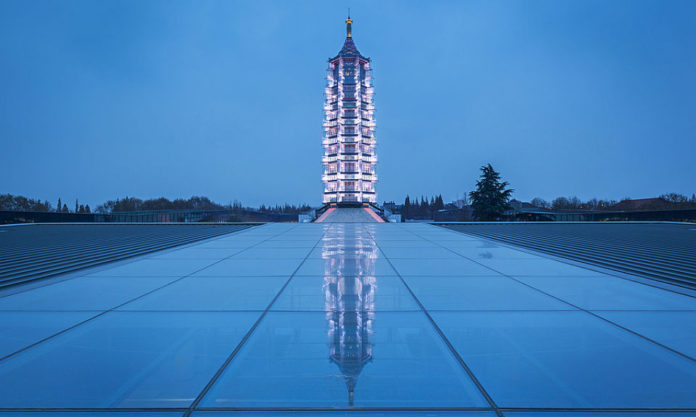Just as other ancient capitals, Nanjing is a city of old-time wonders, and also one of loss and sorrow, witness to the rise and fall of many dynasties and empires. Among all of the city’s lost wonders, the Porcelain Tower may be the most famous.
Although, like many historical buildings, the Porcelain Tower (大报恩寺; Temple of Gratitude) was destroyed in war more than a 100 years ago, today its replica stands in the very same spot, perhaps to remind us of the city’s ancient glory.
From the day it was built more than 600 years ago, the Porcelain Tower of Nanjing maintained itself as a world-class wonder. Ancient records show that the tower was octagonal in shape, and it rose to a height of nearly 80 metres, taller than most of the country’s pagodas.
The more incredible fact is that the tower was built with porcelain bricks, which glinted marvellously in the sunlight.
Western missionaries and ambassadors depicted this amazing scene with great enthusiasm, making this Chinese wonder familiar to Western readers. Even Hans Christian Andersen mentioned the Porcelain Tower in his fairy tale, “The Nightingale”.
From Fiction to Fact; A Wonder of the Middle Ages
Various lists of the Wonders of the World have been compiled through the ages. Best known is the Seven Wonders of the Ancient World, but many others have emerged to address other periods and forms; natural wonders, underwater wonders, etc. Among them, the website, 7wonders.org, lists Nanjing’s original Porcelain Tower as one of the Wonders of the Middle Ages, together with the Leaning Tower of Pisa, the Taj Mahal and the Roman Colosseum, among others.

However, the Porcelain Tower wonder was ruthlessly destroyed in 1856 during the Taiping Rebellion, as rebels feared that their enemy might use the tower as a vantage point to bombard the city.
Although it is impossible to restore the tower to its full, original glory, the replica, built on the tower’s original location, does its best to preserve the charm of the ancient site.
Now surrounding the rebuilt tower is a modern museum that contains many precious relics of the Porcelain Pagoda. Small ornaments made of gems, porcelain bricks and assorted remains of the old tower on display take the modern visitor on a journey of imagination back to the glory of hundreds of years ago.
Herein, the most notable relic is a pure-gold shrine, containing what was believed to be bone relics of the Buddha. The museum also displays the unearthed underground foundation of the original tower. All of these, in a modern museum of steel and glass, blend our senses of past and present.
If you are confident about your fitness, you can try to ascend the porcelain tower replica. Although the climb might be a bit of a challenge, for the tower is ten stories high, it is certainly worthwhile.
The pinnacle is an excellent vantage point from which to appreciate Nanjing’s skyline. The historical and modern aspects meet again, as the ancient, vine-covered stones of the City Wall encompass the old town that is today packed with skyscrapers.









